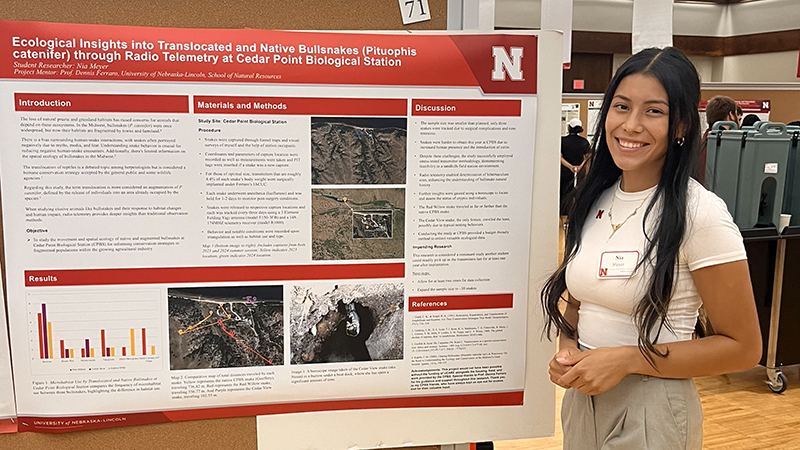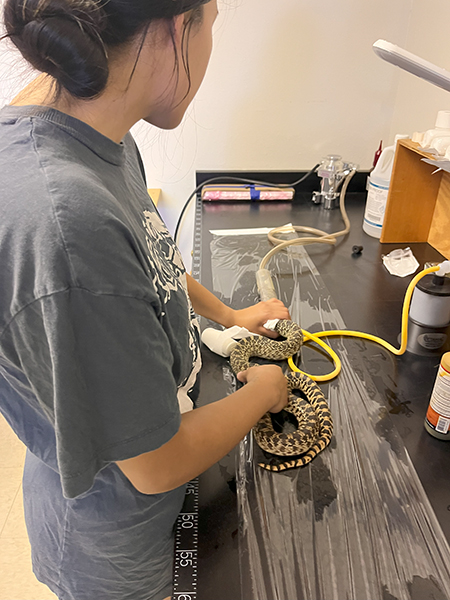Posted: 9/19/2024
Meyer gets the lowdown on bullsnakes at Cedar Point

By Ronica Stromberg
For Husker senior Nia Meyer, her stay at Cedar Point Biological Station this past summer might be termed 'all-inclusive.' From snake rescue to snake surgery to snake CPR and a cool-looking snake bite, Meyer experienced it all in a UCARE project in western Nebraska from May 26 to August 2, 2024.
In her Undergraduate Creative Activities and Research Experiences project, the fisheries and wildlife major received a salary and room and board through the Pepsi Endowment and Program of Excellence funds, but bullsnakes also contributed their share to the experience.
The largest snake native to Nebraska, bullsnakes can grow up to about eight feet long. They are commonly referred to as "the farmer's friend" because they eat rodents that feed on crops. They are also called 'gopher snakes' because they are often found in abandoned burrows of small mammals.
Meyer worked with Dennis Ferraro, a herpetology professor, to research how these snakes use the land at the Cedar Point Biological Station near Lake McConaughy. Her initial plan was for Ferraro to install transmitters on snakes she found so that she could then track them using radio telemetry.
That plan ran afoul when she found only one bullsnake, a male PIT tagged by students the previous summer."I had to tweak my study a little bit," Meyer said. "Instead of just the spatial ecology of the bullsnakes on Cedar Point that are native to just that specific area, we brought in two.”
Ferraro found a recruit at Red Willow State Park, and he and Meyer came to the rescue of an imperiled female bullsnake at Lake McConaughy.
"Some kids were shoving hand sanitizer in its mouth in one of the bathrooms, and as soon as the janitor saw, they alerted Nebraska Game and Parks, and then they called us," Meyer said. "We went to go grab it, and Dennis said, 'I think it's safer here, so no kids can mess with it.'
Back at Cedar Point, with three bullsnakes now, Meyer’s research turned into a study on how the translocated snakes versus the native snake would use the land. Ferraro surgically inserted a transmitter in the abdomen of each snake, and Meyer helped by holding the snakes while they received anesthesia.

"It was really cool to see surgeries being done firsthand," Meyer said. "It made me actually realize, ‘Good thing I did not take the pre-vet path because having a life in your hands, and just one little cut too deep that could go wrong.’ Dennis talked us [students] through it while he was doing it. And to resuscitate the snakes, just to wake them up and make sure they're OK, I got to see snake CPR."
Never heard of snake CPR? Neither had Meyer.
"Dennis always pulls some method out of nowhere," she said.
In snake CPR, Ferraro inserted a ridged pipette (with the bulb cut off) into the snake's respiratory tract and blew into the bulb end as if it were a balloon. He imitated the breathing of the snake and watched for movement in its tail to indicate it was waking and recovering from the anesthesia.
The professor's vast knowledge like this on reptiles, amphibians and turtles and his passion for his work had impressed Meyer in past classes she took with him, she said. He had become her favorite teacher, and she enjoyed learning from him on the UCARE project also, she said.
After outfitting the bullsnakes with transmitters and ensuring their recovery from surgery, the scientists set them free at Cedar Point. Meyer then used radio telemetry to track them, carrying a handheld antenna and receiver to pick up the signals of the individual transmitters. The transmitters on the snakes were set to different radio frequencies. Meyer entered the frequency of a snake into the receiver when she wanted to find it.
"It's like a game of hot and cold," she explained. "So, when you're listening, you have to tune the receiver, so there's going to be a beep, and the louder it is, the closer you are. The fainter the beep, the farther away you are."
Since she had only three bullsnakes to track and only a month to track them in, she said her results couldn’t be considered scientifically conclusive. She also said studies should have at least two years of data, so another student could continue the research next summer to build the data.
Regardless of the study’s limitations, Meyer said she learned a few things about bullsnakes.
"They're all around you, and you probably have stepped over a few because there were times when I had," she said. "I didn't see where it was until the beeping was very loud, right under my feet. They're very elusive animals, and it was really cool to see where they were hiding, because some of them were in woodpiles. Some were under cabins or just under big rocks."
When she found a snake, she recorded the temperature of the air and ground and conditions of the site, like whether rocky ground or tree- or grass-covered and whether wet or dry. She entered into Google maps the location and the name of the snake found, having named the snakes Geoffrey, Nessa and Willow.
"Dennis told me you shouldn't be naming them, but for visualizing the snakes on the map, when I used Google Maps, I'd rather have names instead of a bunch of numbers jumbled on the map," she said.
Later, when Nessa, the snake rescued from having her mouth washed out with soap, did not seem to move from a burrow for several days, Meyer checked on the snake’s welfare by using a borescope, a camera on the inside of a long antenna. She then carefully dug away the burrow with a shovel, and the snake came out.
"She was doing perfectly fine," Meyer said. "She healed great, so that's how I knew the method I was using worked."
Meyer also learned through the research how to take measurements on the snakes and check their gender by probing their genital opening, the cloaca. Nessa bit Meyer during this exam.
"You kind of have to be understanding when you're working with animals," Meyer said. "They don't know what you’re doing. She was probably just so scared, but actually, with bullsnakes, their bite does not hurt, surprisingly."
Bullsnakes' teeth are tiny and face inward, so Meyer waited until the snake let go naturally rather than risk tearing skin. Still, the bite left pin-prick marks that Meyer said were cool to show other students in the short time they remained visible.
She said she made many friends during her UCARE experience and will always look back on it with fondness. She is considering graduate school now and said she would like to work at a zoo also. For students thinking about doing a UCARE project, she has a few words of advice.
"Yes, do it!"